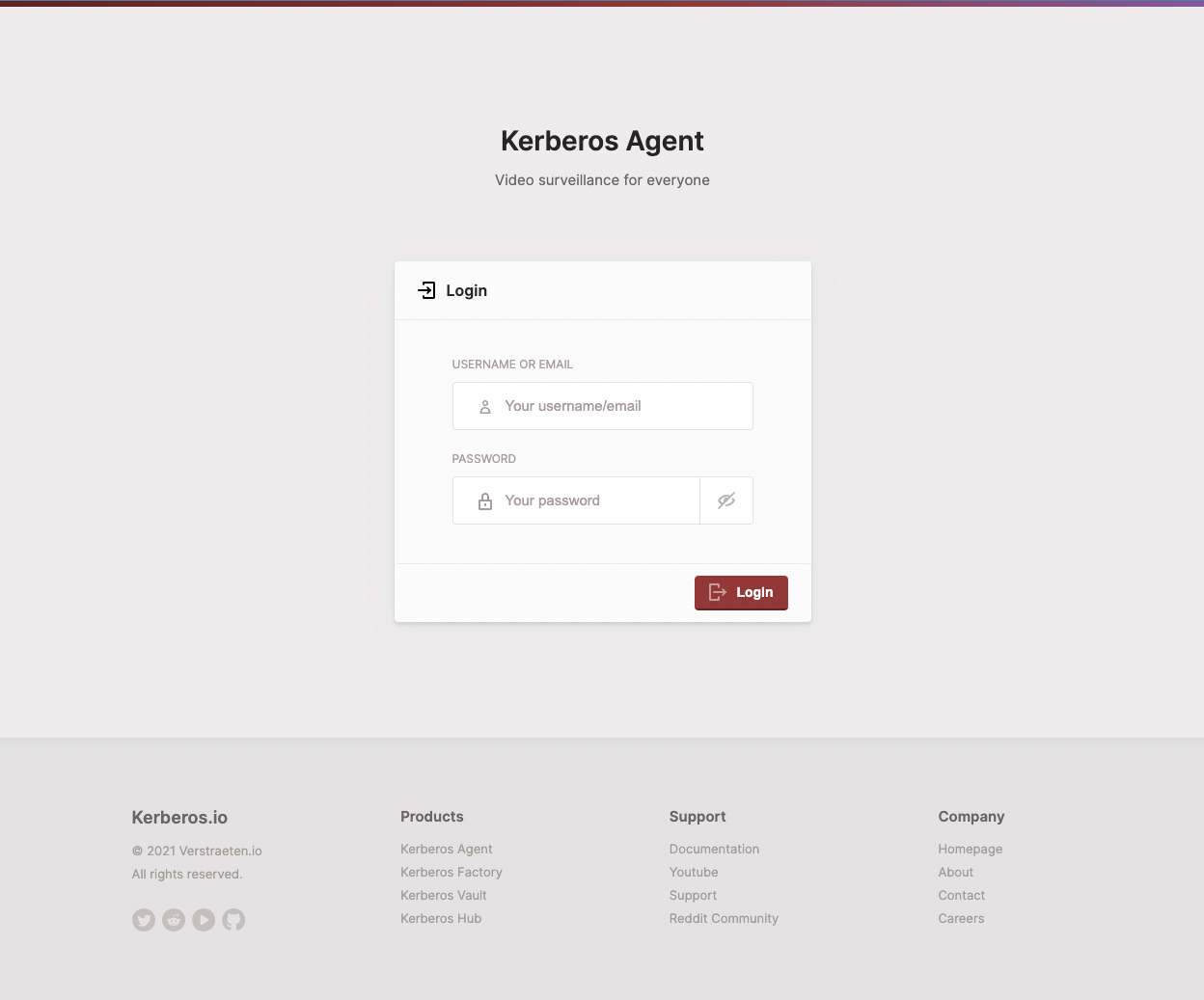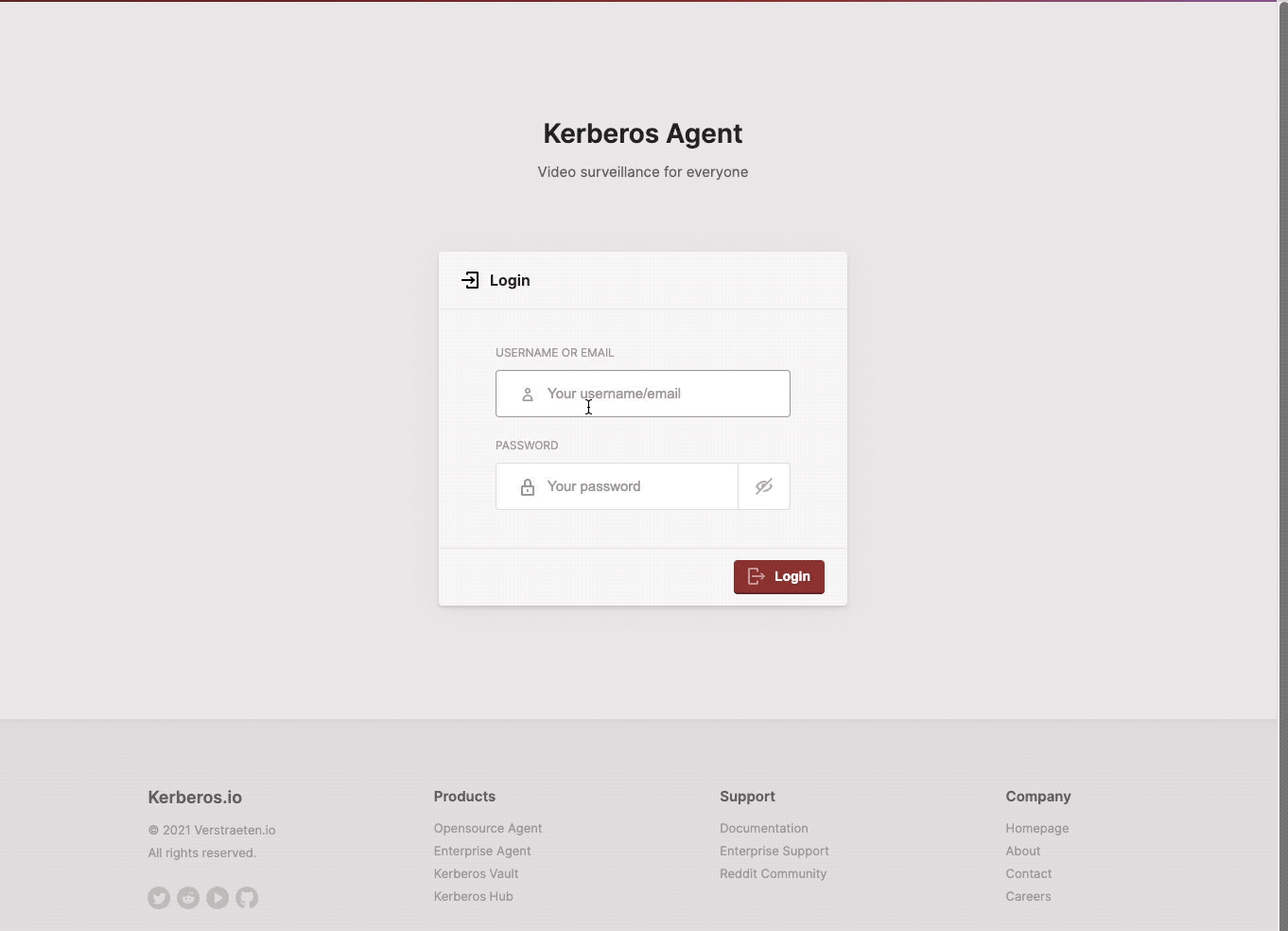Docker Hub | Documentation | Website
Kerberos Agent is a cutting edge video surveillance management system made available as Open Source under the MIT License. This means that all the source code is available for you or your company, and you can use, transform and distribute the source code; as long you keep a reference of the original license. Kerberos Agent can be used for commercial usage (which was not the case for v2). Read more about the license here.
If you like our product please feel free to execute an Ethereum donation. All donations will flow back and split to our Open Source contributors, as they are the heart of this community.
Ethereum Address: 0xf4a759C9436E2280Ea9cdd23d3144D95538fF4bE
Kerberos Agent (v3) is not yet released, and is actively developed. You can follow the progress on our project board and review our designs at Figma. Feel free to give any feedback.
This repository contains the next generation of Kerberos.io, Kerberos Agent (v3), and is the successor of the machinery and web repositories. A switch in technologies and architecture has been made. This version is still under active development and can be followed on the develop branch and project overview.
Read more about this at the FAQ below.
Kerberos.io is a cutting edge video surveillance system with a strong focus on user experience, scalability, resilience, extension and integration. Kerberos.io provides different solutions, but from a high level point of view it comes into two flavours: Kerberos Agent and Kerberos Enterprise Suite. Bottom line Kerberos Enterprise Suite extends Kerberos Agent with additional components such as Kerberos Factory, Kerberos Vault and Kerberos Hub.
- Installation in seconds (Kerberos Etcher, Docker, Binaries).
- Simplified and modern user interface.
- Multi architecture (ARMv7, ARMv8, amd64, etc).
- Multi camera support: IP Cameras (MJPEG/H264), USB cameras, Raspberry Pi Cameras.
- Single camera per instance (e.g. One Docker container per camera).
- Cloud integration through Webhooks, MQTT, etc.
- Cloud storage through Kerberos Hub.
- MIT License
Kerberos Factory (part of Kerberos Enterprise suite)
- Installation on top of Kubernetes (K8S).
- Camera support for IP camera only (RTSP/H264).
- Massive horizontal scaling, thanks to Kubernetes.
- Management of multiple Kerberos Agents through a single pane of glass.
- Low memory and CPU intensive.
- Modular and extensible design for building own extensions and integrations (e.g. a video analytics platform).
- Commercial licensed and closed source.
Kerberos.io applies the concept of agents. An agent is running next to or on your camera, and is processing a single camera feed. It applies motion based recording and make those recordings available through a user friendly web interface. Kerberos Agent allows you to connect to other cloud services or custom applications. Kerberos Agent is perfect for personal usage and/or is a great tool if you only have a couple of surveillance cameras to be processed.
If you are looking for a solution that scales better with your video surveillance and/or video analytics requirements, Kerberos Enterprise Suite might be a better fit.
Kerberos Agent will ship in different formats: Docker, binary, snap, KiOS. Version 3 is still in active development right now, and not yet released.
Kerberos Agent is divided in two parts a machinery and web. Both parts live in this repository in their relative folders. For development or running the application on your local machine, you have to run both the machinery and the web as described below. When running in production everything is shipped as only one artifact, read more about this at Building for production.
The web is a React project which is the main entry point for an end user to view recordings, a livestream, and modify the configuration of the machinery.
git clone https://github.com/kerberos-io/agent
cd ui
yarn start
This will start a webserver and launches the web app on port 3000.
The machinery is a Golang project which delivers two functions: it acts as the Kerberos Agent which is doing all the heavy lifting with camera processing and other kinds of logic, on the other hand it acts as a webserver (Rest API) that allows communication from the web (React) or any other custom application. The API is documented using swagger.
You can simply run the machinery using following commands.
git clone https://github.com/kerberos-io/agent
cd machinery
go run main.go run mycameraname 8080
This will launch the Kerberos Agent and run a webserver on port 8080. You can change the port by your own preference. We strongly support the usage of Goland, as it comes with all the debugging and linting features builtin.
Running Kerberos Agent in production only require a single binary to run. Nevertheless, we have two parts, the machinery and the web, we merge them during build time. So this is what happens.
To build the Kerberos Agent web app, you simply have to run the build command of yarn. This will create a build directory inside the web directory, which contains a minified version of the React application. Other than that, we also move this build directory to the machinery directory.
cd ui
yarn build
Building the machinery is also super easy 🚀, by using go build you can create a single binary which ships it all; thank you Golang. After building you will endup with a binary called main, this is what contains everything you need to run Kerberos Agent.
Remember the build step of the web part, during build time we move the build directory to the machinery directory. Inside the machinery web server we reference the build directory. This makes it possible to just a have single web server that runs it all.
cd machinery
go build
Inside the root of this agent repository, you will find a Dockerfile. This file contains the instructions for building and shipping Kerberos Agent. Important to note is that start from a prebuild base image, kerberos/debian-opencv-ffmpeg:1.0.xxx.
This base image contains already a couple of tools, such as Golang, FFmpeg and OpenCV. We do this for faster compilation times.
By running the docker build command, you will create the Kerberos Agent Docker image. After building you can simply run the image as a Docker container.
docker build -t kerberos/agent .
docker run -p 8080:8080 --name mycamera -d kerberos/agent:edge
We have noticed in the past (v1 and v2) splitting the repositories (machinery and web), created a lot of confusion within our community. People didn't understand the different versions and so on. This caused a lack of collaboration, and made it impossible for some people to collaborate and contribute.
Having a mono repo, which is well organised, simplifies the entry point for new people who would like to use, understand and/or contribute to Kerberos Agent.
In previous versions (v1 and v2) we used technologies like C++, PHP and BackboneJS. 7 years ago this was still acceptable, however time has changed and new technologies such as React and Golang became very popular.
Due to previous reason we have decided to rebuild the Kerberos Agent technology from scratch, taking into account all the feedback we acquired over the years. Having these technologies available, we will enable more people to contribute and use our technology.
We started the developments of Kerberos Enterprise a year ago (January, 2020), our focus here was scalability, and fast development and easy deployment. We noticed that with technologies such as Golang and React, we can still provide a highly performant video surveillance system.
Kerberos Agent uses the same technology stack, and some code pieces, of Kerberos Enterprise which we have already build. We have a very clear now, of how a well developed and documented video surveillance system needs to look like.
We plan to ship the first version by the end of Q1, afterwards we will add more and more features as usual.
Kerberos Agent (v3) is now available under the MIT license.
This project exists thanks to all the people who contribute.








